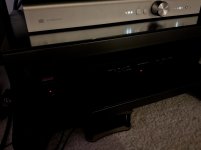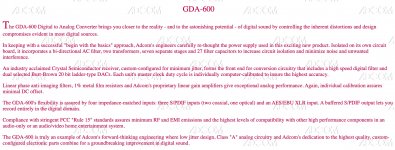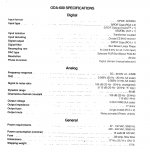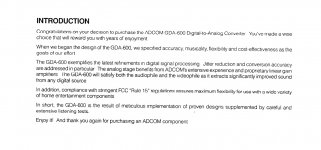Hey folks,
In search for DAC I'd like. The whole story started with Behringer DEQ2496, which I had for years collecting dust, and a couple weeks ago decided to put it into work modded with 1:1 transformers. It is not a big deal to make a good 1:1 transformer, esp. on UI double bobbin core. For that application I greatly prefer UI over EI and even over torroid. Not the least for keeping capacitance and copper resistance for given inductance way down. Since we make transformers for our own products all day long that part was a breeze...
At this point I deliberately avoid any capacitor, or PSU mods, as first, I'd like to find the right topology. After all, those are already details. The main part is, if the thing sounds good with inferior parts it is already a good start...
The original Behringer was quite horrible--flat, uninteresting, Grey, with no distinct character, straight into your face. Even with SMD the tracing and surgery did not take too long, so at the end of the evening I was already enjoying quite a drastic change. The CD's I was listening were Bill Evans Waltz for Debbie, Stan Getz/Gilberto, K. Battle with W. Marsalis, and Michel Petrucciani with Jim Hall. That was a 'night and day' difference. Entire soundstage greatly improved, partially due to the removing NF. The sound became pretty pleasant and the most apparent was its sweetness and great instrument separation.
Last week I picked up Adcom GDA 600 for $100. Even stock it was apparent being more HiFi--very clear and defined attacks. Good instrument separation. Sound was a bit flat and I felt some compression, but I was not too worried, as that was rather due to the NF, so with a transformer and removing NF I felt it will 'free up'.
So now there is a bit of challenge. One thing is to make a good 1:1 transformer, which is not a big deal. Since PCM63 is an 'I' output we need at least 1:10, which for the same quality of 1:1 is by far less trivial task. Clearly, it is absolutely should be UI and for the good coupling perhaps interleaved (yep, even for the dual bobbin!!!). Since we had in the shop a couple of already wound 10:1, just to try the concept and get things rolling for now I decided to use those backwards. Since it is very high quality unit, for checking the concept it should work fine.
Since the schematics is readily available it took about an hour to trace things, disconnect Opamp input and output, cut traces, unsolder a few parts and then connect the transformer from the pins 5-6 to the output to the relay inputs 8 and 9, with a couple 9.09kΩ cube Vishays across the secondary.
As I expected, the soundstage improved, flatness was gone--time to enjoy the music. In comparison to Behringer--much less distortions, much better sound definition, much more HiFi. With Stan Getz saxophone I could immediately hear the natural room reverberation--those details totally lost in Behringer. K. Battle--no comparison--the Adcom wins hands down. With Bill Evans--all nice, clear, and detailed.
But then... I still was coming back to Behringer and enjoy its sweetness and depth of stage. That is, while the Adcom sounds nice, noble and clear, it still stays at the level of speakers. The Behringer with all its fuzziness and lack of details goes deep into the back of the room. Then I put M. Petrucciani with Jim Hall and... cannot go back to the Adcom--with all distortions, with all imperfections, with all fuzziness, with all lowerFi, it is so much more musical (whatever it means), the soundstage is deeper, that it just... wins on that particular recording...
So now the questions: what to do next? I want the definition, high quality, low distortions, nobility of the PCM63 in Adcom, but I also want that sweetness, musicality, and room depth of the AKM4393 in Behringer.
Speak your mind, folks!
Best, Mark Fouxman
Samar Audion Design, LLC
SAMAR Audio & Omni8 Audio
In search for DAC I'd like. The whole story started with Behringer DEQ2496, which I had for years collecting dust, and a couple weeks ago decided to put it into work modded with 1:1 transformers. It is not a big deal to make a good 1:1 transformer, esp. on UI double bobbin core. For that application I greatly prefer UI over EI and even over torroid. Not the least for keeping capacitance and copper resistance for given inductance way down. Since we make transformers for our own products all day long that part was a breeze...
At this point I deliberately avoid any capacitor, or PSU mods, as first, I'd like to find the right topology. After all, those are already details. The main part is, if the thing sounds good with inferior parts it is already a good start...
The original Behringer was quite horrible--flat, uninteresting, Grey, with no distinct character, straight into your face. Even with SMD the tracing and surgery did not take too long, so at the end of the evening I was already enjoying quite a drastic change. The CD's I was listening were Bill Evans Waltz for Debbie, Stan Getz/Gilberto, K. Battle with W. Marsalis, and Michel Petrucciani with Jim Hall. That was a 'night and day' difference. Entire soundstage greatly improved, partially due to the removing NF. The sound became pretty pleasant and the most apparent was its sweetness and great instrument separation.
Last week I picked up Adcom GDA 600 for $100. Even stock it was apparent being more HiFi--very clear and defined attacks. Good instrument separation. Sound was a bit flat and I felt some compression, but I was not too worried, as that was rather due to the NF, so with a transformer and removing NF I felt it will 'free up'.
So now there is a bit of challenge. One thing is to make a good 1:1 transformer, which is not a big deal. Since PCM63 is an 'I' output we need at least 1:10, which for the same quality of 1:1 is by far less trivial task. Clearly, it is absolutely should be UI and for the good coupling perhaps interleaved (yep, even for the dual bobbin!!!). Since we had in the shop a couple of already wound 10:1, just to try the concept and get things rolling for now I decided to use those backwards. Since it is very high quality unit, for checking the concept it should work fine.
Since the schematics is readily available it took about an hour to trace things, disconnect Opamp input and output, cut traces, unsolder a few parts and then connect the transformer from the pins 5-6 to the output to the relay inputs 8 and 9, with a couple 9.09kΩ cube Vishays across the secondary.
As I expected, the soundstage improved, flatness was gone--time to enjoy the music. In comparison to Behringer--much less distortions, much better sound definition, much more HiFi. With Stan Getz saxophone I could immediately hear the natural room reverberation--those details totally lost in Behringer. K. Battle--no comparison--the Adcom wins hands down. With Bill Evans--all nice, clear, and detailed.
But then... I still was coming back to Behringer and enjoy its sweetness and depth of stage. That is, while the Adcom sounds nice, noble and clear, it still stays at the level of speakers. The Behringer with all its fuzziness and lack of details goes deep into the back of the room. Then I put M. Petrucciani with Jim Hall and... cannot go back to the Adcom--with all distortions, with all imperfections, with all fuzziness, with all lowerFi, it is so much more musical (whatever it means), the soundstage is deeper, that it just... wins on that particular recording...
So now the questions: what to do next? I want the definition, high quality, low distortions, nobility of the PCM63 in Adcom, but I also want that sweetness, musicality, and room depth of the AKM4393 in Behringer.
Speak your mind, folks!
Best, Mark Fouxman
Samar Audion Design, LLC
SAMAR Audio & Omni8 Audio
It will likely result in frustration, when hoping to achieve some specific sound character by splicing together technical bits borrowed from other devices, which each exhibit differeing aspects of that character.
That said, here's a suggestion to consider. Depending on your skill level, and if you can get hold of a schematic of the Behringer, and assuming that the DAC chip utilized by the Behringer is a current output device, you might try building a version of the Behringer's analog section for to replace that used in the Adcom..
That said, here's a suggestion to consider. Depending on your skill level, and if you can get hold of a schematic of the Behringer, and assuming that the DAC chip utilized by the Behringer is a current output device, you might try building a version of the Behringer's analog section for to replace that used in the Adcom..
Thank you for your thoughts. As I mentioned, entire opamp stages were bypassed in both DACs and I used transformers, instead.
My feeling it is rather sonic signature of the PCM63 and AKM4393 chips, so wanted some opinions if that's correct. If so, what other DAC chips would people suggest to try to get some kind of middle compromise for the sonics I am looking for?
Best, M
My feeling it is rather sonic signature of the PCM63 and AKM4393 chips, so wanted some opinions if that's correct. If so, what other DAC chips would people suggest to try to get some kind of middle compromise for the sonics I am looking for?
Best, M
I expect this will be my final comment here.
There is no technical formula for obtaining an certain subjective sonic character - in all it's aspects - from a DAC. Building a Franken-DAC from various technology bits borrowed from other DACs in pursuit of that goal would be a haphazard endeavor. There are many implementation factors responsible for the sonics of an DAC. Those details form an unpredictable whole in terms of the overall sonic character. Just some of the implementation factors are the digital filter, the clock generator, the jitter suppression, and the supply regulation - and that's just the digital section. The analog section entails a separate set of implementation factors. Even should you successfully identify the specific implementation details that produce certain aspects of the sound you're seeking from among several DACs, that doesn't tell you which details to combine and how to combine them.
Where does this leave you? Unfortunately, facing much time, effort and frustration in trial and error experimentation. Welcome to the world of DIY . Perhaps, you will get lucky and stumble across the golden implementation combination sooner rather than later. However, I think it more likely, I'm sorry to say, that you never stumble across that.
. Perhaps, you will get lucky and stumble across the golden implementation combination sooner rather than later. However, I think it more likely, I'm sorry to say, that you never stumble across that.
There is no technical formula for obtaining an certain subjective sonic character - in all it's aspects - from a DAC. Building a Franken-DAC from various technology bits borrowed from other DACs in pursuit of that goal would be a haphazard endeavor. There are many implementation factors responsible for the sonics of an DAC. Those details form an unpredictable whole in terms of the overall sonic character. Just some of the implementation factors are the digital filter, the clock generator, the jitter suppression, and the supply regulation - and that's just the digital section. The analog section entails a separate set of implementation factors. Even should you successfully identify the specific implementation details that produce certain aspects of the sound you're seeking from among several DACs, that doesn't tell you which details to combine and how to combine them.
Where does this leave you? Unfortunately, facing much time, effort and frustration in trial and error experimentation. Welcome to the world of DIY
Ooops, my mistake to forget you'd used a trafo - I got carried away with imaginings about the schematic, once I found it. The output filtering in that document shows a single pole from the I/V opamp followed by a third order Sallen-Key type filter. When you fit the trafo your only low-pass filtering is from that trafo's leakage inductance in conjunction with its load impedance (your Vishays). I'd suggest more aggressive LP filtering than just a single pole.
There's another issue to consider - the PCM63's output impedance is surprisingly low for what's ostensibly a current output, it really needs a much lower impedance on its output (I'd suggest <5R myself). You didn't say whether your Vishays were put in series or parallel but assuming the latter it looks like you may have about 50ohm in practice.
DAC designers pretty much all concur that the vast majority of a D/A box's sonics comes from the ancillary circuits around the DAC rather than the chip itself. Hence I'd not bother swapping DAC chips until you've exhausted all the possibilities offered by mods to the support circuitry.
There's another issue to consider - the PCM63's output impedance is surprisingly low for what's ostensibly a current output, it really needs a much lower impedance on its output (I'd suggest <5R myself). You didn't say whether your Vishays were put in series or parallel but assuming the latter it looks like you may have about 50ohm in practice.
DAC designers pretty much all concur that the vast majority of a D/A box's sonics comes from the ancillary circuits around the DAC rather than the chip itself. Hence I'd not bother swapping DAC chips until you've exhausted all the possibilities offered by mods to the support circuitry.
Thank you!
It is leakage and also winding capacitance. Our 1:10 transformers are good to about 70kHz @-3dB. What are the filter requirements here?
This part is confusing. The PCM63 datasheet shows output impedance as 670Ω. What I have right now with 1:10 is 9.09kΩ/(10x10)=90Ω, so with all losses it around 100Ω reflected load. The 5Ω will ask for 5x10x10=some 500Ω, which would suck lots of signal. If indeed to use 5Ω as a source impedance then we could easily make a high quality transformer of some 1:30, or even 1:40 ratio with still good low end response and quite low secondary copper resistance to compensate for signal loading.
In any case, at home the lowest resistor I could find was 2.65kΩ VishayDale, so to check if it makes any difference I put it in parallel with existing 9.09kΩ for some 25Ω load and indeed, things greatly improved. Will check at work for smaller values and check it tonight.
I was thinking of changing clock. Any suggestions here?
Best, M
Ooops, my mistake to forget you'd used a trafo - I got carried away with imaginings about the schematic, once I found it. The output filtering in that document shows a single pole from the I/V opamp followed by a third order Sallen-Key type filter. When you fit the trafo your only low-pass filtering is from that trafo's leakage inductance in conjunction with its load impedance (your Vishays). I'd suggest more aggressive LP filtering than just a single pole.
It is leakage and also winding capacitance. Our 1:10 transformers are good to about 70kHz @-3dB. What are the filter requirements here?
There's another issue to consider - the PCM63's output impedance is surprisingly low for what's ostensibly a current output, it really needs a much lower impedance on its output (I'd suggest <5R myself). You didn't say whether your Vishays were put in series or parallel but assuming the latter it looks like you may have about 50ohm in practice.
This part is confusing. The PCM63 datasheet shows output impedance as 670Ω. What I have right now with 1:10 is 9.09kΩ/(10x10)=90Ω, so with all losses it around 100Ω reflected load. The 5Ω will ask for 5x10x10=some 500Ω, which would suck lots of signal. If indeed to use 5Ω as a source impedance then we could easily make a high quality transformer of some 1:30, or even 1:40 ratio with still good low end response and quite low secondary copper resistance to compensate for signal loading.
In any case, at home the lowest resistor I could find was 2.65kΩ VishayDale, so to check if it makes any difference I put it in parallel with existing 9.09kΩ for some 25Ω load and indeed, things greatly improved. Will check at work for smaller values and check it tonight.
DAC designers pretty much all concur that the vast majority of a D/A box's sonics comes from the ancillary circuits around the DAC rather than the chip itself. Hence I'd not bother swapping DAC chips until you've exhausted all the possibilities offered by mods to the support circuitry.
I was thinking of changing clock. Any suggestions here?
Best, M
Last edited:
I agree with Ken Newton. You will need to experiment.
I usually start with the power supply.
The Adcom dac is old and some new power supply capacitors will help, I replaced all the electrolytics.
Then replace the diodes with ultra fast or schottky.
I then added a third power supply transformer, diodes and filter caps to run the digital and analog + and - 5v supply. This left the + and - 15v supply for the audio op amps on thier own transformer.
Once the power supply is sorted I looked at the I/V and Opamps.
It has been years since I did this project but will see If I can find some photos.
I usually start with the power supply.
The Adcom dac is old and some new power supply capacitors will help, I replaced all the electrolytics.
Then replace the diodes with ultra fast or schottky.
I then added a third power supply transformer, diodes and filter caps to run the digital and analog + and - 5v supply. This left the + and - 15v supply for the audio op amps on thier own transformer.
Once the power supply is sorted I looked at the I/V and Opamps.
It has been years since I did this project but will see If I can find some photos.
It is leakage and also winding capacitance. Our 1:10 transformers are good to about 70kHz @-3dB. What are the filter requirements here?
I wasn't able to find enough of the schematic to determine whether an OS filter chip is being used. Normally that would be the case so you'd ideally want to be at least 60dB down before the first images show up (at 8X OS that's in the 300kHz region). However reducing the bandwidth further tends to reduce the contribution from glitches I'd suggest.
I'd say definitely worth a try at 1:40. In my present DAC development I'm using a 1:100 and getting very pleasing subjective results, however that's not in conjunction with PCM63, I'm using a much higher Zout DAC and paralleling them to get enough signal level out into passive I/V.This part is confusing. The PCM63 datasheet shows output impedance as 670Ω. What I have right now with 1:10 is 9.09kΩ/(10x10)=90Ω, so with all losses it around 100Ω reflected load. The 5Ω will ask for 5x10x10=some 500Ω, which would suck lots of signal. If indeed to use 5Ω as a source impedance then we could easily make a high quality transformer of some 1:30, or even 1:40 ratio with still good low end response and quite low secondary copper resistance to compensate for signal loading.
Useful result, thanks!In any case, at home the lowest resistor I could find was 2.65kΩ VishayDale, so to check if it makes any difference I put it in parallel with existing 9.09kΩ for some 25Ω load and indeed, things greatly improved. Will check at work for smaller values and check it tonight.
Clocks are an area where I have zero practical knowledge to share. In my experience with multibit DACs, clock stability hasn't been the low-hanging fruit.I was thinking of changing clock. Any suggestions here?
Just keep it stock?
Anyone like it stock (with excellent transport)? I think it has a fun raw sound & wide open. Personally would not want to mod*, interesting R-2R BurrBrown PCM63 history at this point haha; and what a robust built piece, timeless.
Other details:
SBAF DAC Talk II | Page 55 | Super Best Audio Friends
SBAF DAC Talk II | Page 55 | Super Best Audio Friends
* but bet it is amazing if you did!
Anyone like it stock (with excellent transport)? I think it has a fun raw sound & wide open. Personally would not want to mod*, interesting R-2R BurrBrown PCM63 history at this point haha; and what a robust built piece, timeless.
Other details:
SBAF DAC Talk II | Page 55 | Super Best Audio Friends
SBAF DAC Talk II | Page 55 | Super Best Audio Friends
* but bet it is amazing if you did!
Attachments
-
 IMG_0089.jpeg672.6 KB · Views: 111
IMG_0089.jpeg672.6 KB · Views: 111 -
Adcom-GDA-600-Schematic (1).pdf159 KB · Views: 100
-
gda600 (1).pdf481.6 KB · Views: 79
-
 Screen Shot 2021-10-03 at 9.20.08 PM.jpg605.3 KB · Views: 118
Screen Shot 2021-10-03 at 9.20.08 PM.jpg605.3 KB · Views: 118 -
 Screen Shot 2021-10-03 at 9.16.49 PM.jpg399.2 KB · Views: 101
Screen Shot 2021-10-03 at 9.16.49 PM.jpg399.2 KB · Views: 101 -
 Screen Shot 2021-10-03 at 9.11.07 PM.jpg243.3 KB · Views: 101
Screen Shot 2021-10-03 at 9.11.07 PM.jpg243.3 KB · Views: 101
Last edited:
My GDA600 config: DIR9001, DF1704, Japan BB PCM63 K, currently I use LM4562HA, most of the capacitors changed for better quality .., I got all items in stock to build a single-ended version of the Pass Labs D1 I/V stage .., i somehow really like the presentation from this DAC and I believe the Pass mod is the last mod with benefits, and by that will give me even more joy!
Ps. found it for $40 in a thrift store
Ps. found it for $40 in a thrift store
- Home
- Source & Line
- Digital Line Level
- Another Adcom GDA-600 Mod